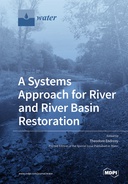Explore

A Systems Approach for River and River Basin Restoration
0 Ungluers have
Faved this Work
Login to Fave
Communities increasingly find that the water quality, water levels, or some other resource indicator in their river basins do not meet their expectations. This discrepancy between the desired and actual state of the resource leads to efforts in river basin restoration. River basins are complex systems, and too often, restoration efforts are ineffective due to a lack of understanding of the purpose of the system, defined by the system structure and function. The river basin structure includes stocks (e.g., water level or quality), inflows (e.g., precipitation or fertilization), outflows (e.g., evaporation or runoff), and positive and negative feedback loops with delays in responsiveness, all of which function to change or stabilize the state of the system (e.g., the stock of interest, such as water level or quality). External drivers on this structure, together with goals and rules, contribute to how a river basin functions. This book reviews several new research projects to identify and rank the twelve most effective leverage points to address discrepancies between the desired and actual state of the river basin system. This book demonstrates that river basin restoration is most likely to succeed when we change paradigms rather than try to change the system elements, as the paradigm will establish the system goals, structure, rules, delays, and parameters.
This book is included in DOAB.
Why read this book? Have your say.
You must be logged in to comment.
Rights Information
Are you the author or publisher of this work? If so, you can claim it as yours by registering as an Unglue.it rights holder.Downloads
This work has been downloaded 112 times via unglue.it ebook links.
- 112 - pdf (CC BY) at Unglue.it.
Keywords
- Bayesian inference
- boulder spacing
- catchment restoration
- CFD simulation
- cotton tensile-strength loss
- Delphi-analytic hierarchy process models
- ecosystem metabolism
- environmental flow component
- environmental Gini coefficient models
- equity and efficiency
- Ethiopia
- evapotranspiration
- Fencing
- flood mapping
- functional indicators
- groundwater modeling
- Heat balance
- holistic environmental flow assessment
- hydraulic complexity
- hydrological foundation
- hyporheic exchange
- hyporheic zone
- indicators of hydrologic alteration software
- Lake Tana
- meander bend
- mechanistic model
- near-bed shear stress
- Nitrates
- organic matter transport
- phosphates
- pollutant load allocation
- rating curve
- regional and site-specific scale
- Restoration
- Reynolds shear stress
- Riparian shading
- riparian vegetation
- River engineering
- River thermal pollution
- self-purification
- stream restoration
- structure-function relationships
- submergence ratio
- systems
- Technology, engineering, agriculture
- Technology: general issues
- total water pollutant control
- turbulent events
- uncertainty
- Urban hydrology
- water quality in streams
- Watershed
- wood decay
Links
DOI: 10.3390/books978-3-03943-632-3Editions

